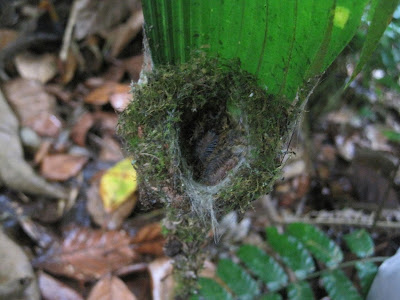This is Julian's seventh year studying these tiny hummingbirds in the rain forest of Trinidad, recording their mating songs and dances, collecting data about these little known and shy birds by watching them, banding them and trying to trace paternity. The Little Hermits live in leks, one lek for their life, and males display for the females by dancing and singing their hearts out in an effort to be chosen by a female for mating. Each lek has its own song and, if a male moves to another lek for some reason, he learns the song of the new lek. Imagine. No one knew this before. As for what more this research will teach us about these hummingbirds, birds in general or the world around us remains to be seen but already it has increased the sense of awe in those who talk to Julian, including me and my grandson pictured below helping make the bands for the hummingbirds. Perhaps it's enough.
29 January 2013
In Praise of Research and Researchers
See those tic tac sized eggs in the incubator? They're Little Hermit Hummingbird eggs and the first photo is one of them candled; the slight red patch is the three day old heart of this soon-to-be hummingbird which I saw beating. The next photo shows the scale to weigh them and the data on the two latest eggs. Two "dummy" eggs replace them in the thimble sized nest so the mother continues to sit on them. Once hatched in 16 days, they will be placed back in the nest and mother will feed them insects and nectar multiple times a day to grow them from a shriveled raisin sized hatchling to a full sized hummingbird in 17 days. It must be fast because they're so vulnerable to predation in their nest close to the ground and attached to the back of a fern frond. They're in the incubator to begin with because they're even more vulnerable as eggs and because Julian, the researcher who lives in a house on my daughters property for four months a year, will swab the inside of the hatched egg for DNA for his research.
This is Julian's seventh year studying these tiny hummingbirds in the rain forest of Trinidad, recording their mating songs and dances, collecting data about these little known and shy birds by watching them, banding them and trying to trace paternity. The Little Hermits live in leks, one lek for their life, and males display for the females by dancing and singing their hearts out in an effort to be chosen by a female for mating. Each lek has its own song and, if a male moves to another lek for some reason, he learns the song of the new lek. Imagine. No one knew this before. As for what more this research will teach us about these hummingbirds, birds in general or the world around us remains to be seen but already it has increased the sense of awe in those who talk to Julian, including me and my grandson pictured below helping make the bands for the hummingbirds. Perhaps it's enough.
This is Julian's seventh year studying these tiny hummingbirds in the rain forest of Trinidad, recording their mating songs and dances, collecting data about these little known and shy birds by watching them, banding them and trying to trace paternity. The Little Hermits live in leks, one lek for their life, and males display for the females by dancing and singing their hearts out in an effort to be chosen by a female for mating. Each lek has its own song and, if a male moves to another lek for some reason, he learns the song of the new lek. Imagine. No one knew this before. As for what more this research will teach us about these hummingbirds, birds in general or the world around us remains to be seen but already it has increased the sense of awe in those who talk to Julian, including me and my grandson pictured below helping make the bands for the hummingbirds. Perhaps it's enough.
Subscribe to:
Post Comments (Atom)






Amazing! This is really cool.
ReplyDeleteIsn't it?
DeleteWow, a great research project.
ReplyDeleteI agree, imagine watching singing and dancing as a way to understand more about a species...
DeleteI love hummingbirds so this project is very interesting to me. I never realized until a few years ago that there are none of these birds in Europe and the hummingbird I thought I'd seen was really a hummingbird moth!
ReplyDeleteSince moving to Italy I found out that there are no hummingbirds in Europe. We have a regular hummingbird moth to our balcony and we too thought it was the bird at first.
DeleteI love hummers, too. I think there is much that is not known about these little guys. A handful of Anna's Hummingbirds winter in our part of the country, even though it can get very cold. They become dependent on people to feed them, which many do. I loved learning this about these little guys! How in the world would you band a hummer? They are so tiny!
ReplyDeleteThey, as small as they are, travel thousands of miles in migration each year. The bands are metal, incredibly small and have five numbers on them for ID purposes. Amazing.
DeleteSo so cool. Thanks. k.
ReplyDeleteIt's good to be in wonder.
Deleteoh wow...this is so cool.. what a wonderful project..and what great things he discovered...loved to learn a bit more about them
ReplyDeleteI'm still learning and will post more as I do.
Deleteomg they are so small...wow...my son would love this...he always wants to know more, explore and experiment....
ReplyDeleteThe link to my daughter's village is on my website for him to explore- you never know...
DeleteThis comment has been removed by a blog administrator.
ReplyDeleteI wonder what hanging out with these researchers will inspire Kahlil to explore.
ReplyDeleteI wonder as well- the guppy researchers were here a couple of days ago and we went hiking with them and then hung out with them for the evening. I found it fascinating and him? Hmmmm.
DeleteYou know, I wanted to let you know one of my daughters is a "researcher" -- in tropical forests/botany--She's also done work in marine biology on the DNA of sea turtles, but her main interest is forest ecology - though with kind of a non-timber focus, I think. k.
ReplyDeleteThat's interesting about your daughter. She should check out the live link on my home page to my daughter's website. Sea turtles lay their eggs on beaches near her on the North Shore of Trinidad some reached only by hiking through the rain forest in which she lives. Bless their efforts.
Delete